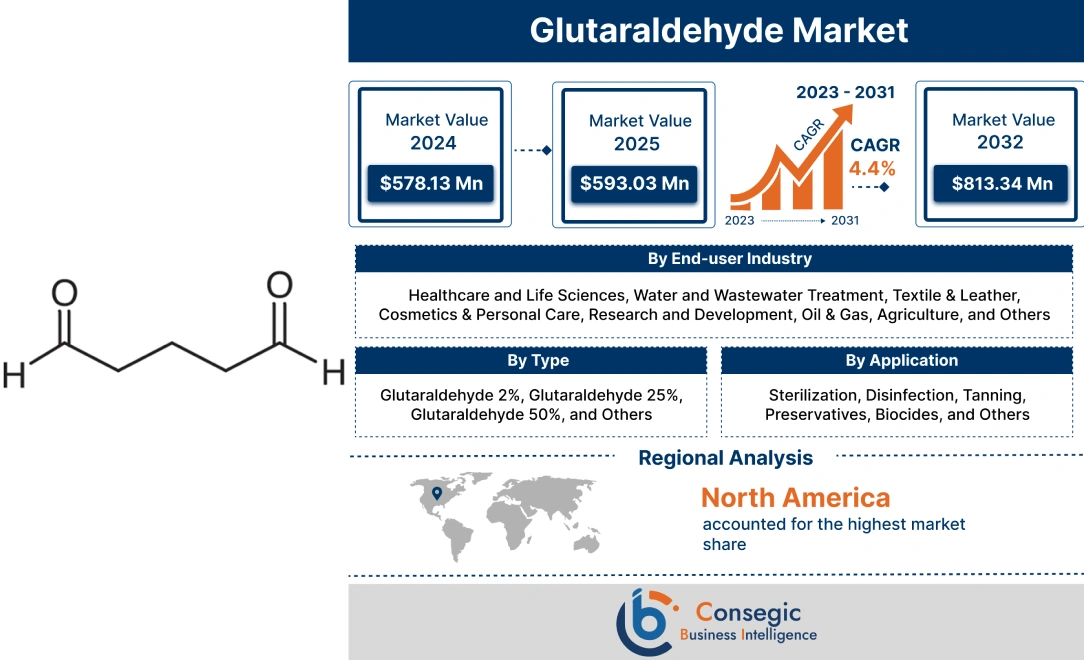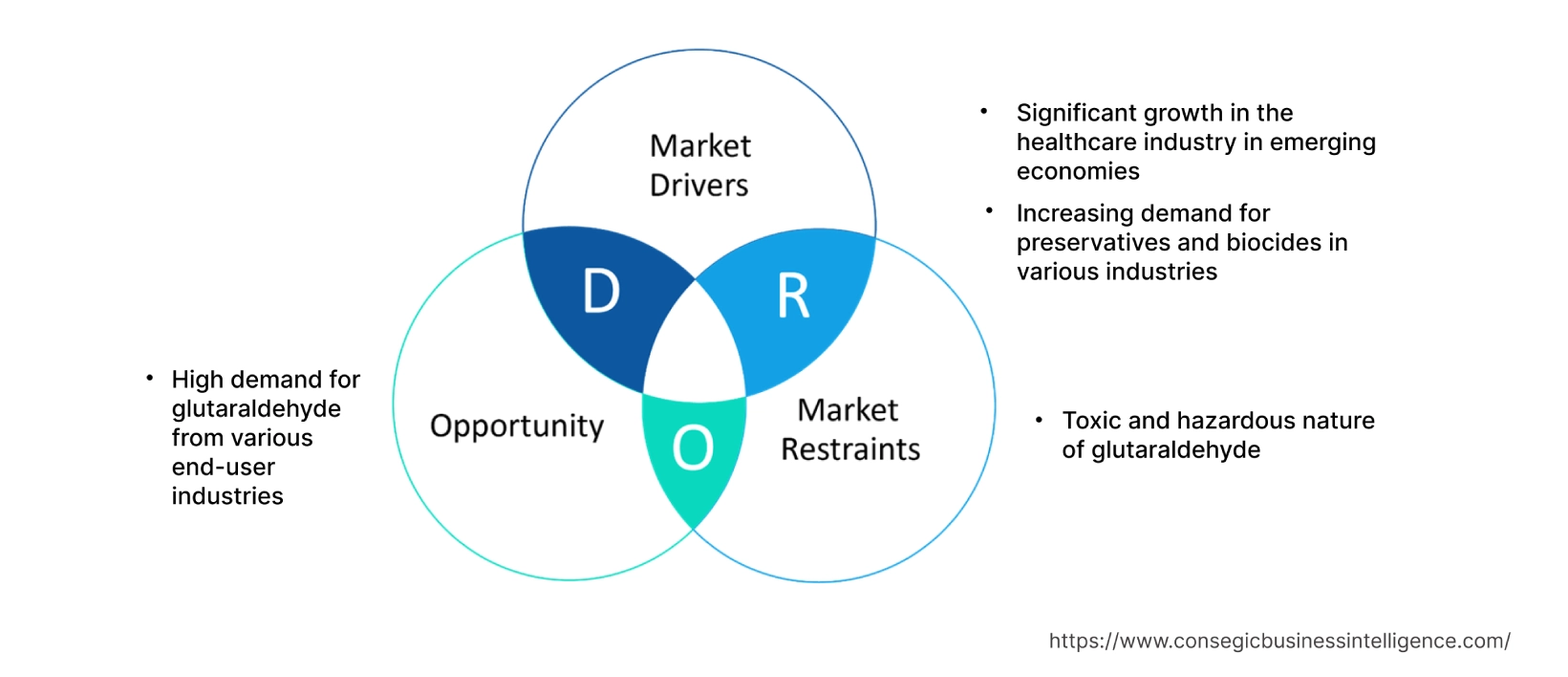- Summary
- Table Of Content
- Methodology
Glutaraldehyde Market Size :
Consegic Business Intelligence analyzes that the Glutaraldehyde Market size is estimated to reach over USD 813.34 Million by 2032 from a value of USD 578.13 Million in 2024 and is projected to grow by USD 593.03 Million in 2025, growing at a CAGR of 4.40% from 2025 to 2032.
Glutaraldehyde Market Scope & Overview :
Glutaraldehyde is an organic compound with the formula (CH2)3(CHO)2. It is a colorless, oily liquid with a sharp, pungent odor. It is a saturated dialdehyde and is used for disinfecting and sterilizing surfaces and equipment. It is used for cold sterilization of dental and medical equipment and as a preservative, biocide, hardener, and tanning agent.
As a disinfectant, it is used to eliminate harmful microorganisms on surgical instruments and has other uses as a fixative or preservative in other parts of a healthcare facility. It is also used as a fixative in biochemical procedures and electron microscopy. It can also be used as a cross-linking and tanning agent and as a biocide in metalworking fluids and oil and gas pipelines.
Glutaraldehyde Market Insights :
Key Drivers :
Significant growth in the healthcare sector in emerging economies Fuels the Market Development
Glutaraldehyde is commonly used to disinfect and sterilize critical and semi-critical medical instruments such as endoscopes, surgical instruments, and dental equipment. It effectively kills a wide range of microorganisms, including bacteria, viruses, and fungi. It is particularly valuable for achieving high-level disinfection, which is necessary for items that come into contact with mucous membranes or non-intact skin. This ensures that medical instruments are safe for reuse between patients. Furthermore, as per the analysis of the healthcare facilities, solutions are used for surface disinfection, including counterparts, medical equipment surfaces, and other high-tough areas. For instance, according to the report by the National Investment Promotion and Facilitation Agency report, the hospital sector in India was valued at USD 61.79 billion in 2017 & and is expected to reach USD 132 billion by 2023, growing at a CAGR of 16%-17%. Hence, the high demand in the healthcare sector is driving the global glutaraldehyde market growth and trends.
Increasing demand for preservatives and biocides in various industries Fuels the Market Development
Glutaraldehyde is primarily used as a preservative and biocide in various end-user industries. It is used as a preservative in biological specimens preservative, histopathology, archival and museum preservation, textile and paper preservation, oilfield chemicals, and others. It is added to oil and gas pipelines to act as a corrosion inhibitor. It helps protect the metal infrastructure from degradation caused by microorganisms, especially sulfate-reducing bacteria (SRB) that can contribute to corrosion. It is also used in cooling water systems, such as those in industrial facilities and power plants, to control the growth of algae, bacteria, and other microorganisms that can foul and damage equipment.
In paper and pulp mills it is employed as a biocide to control microbial contamination in the papermaking process. It helps maintain the quality of the paper products and prevents spoilage. Analysis shows that the significant growth in the production of paper and the growing focus of various paper manufacturers on the development of their manufacturing facilities are driving the glutaraldehyde market demand as a preservative and biocide. For instance, in February 2022, Sappi, a leading provider of sustainable, paper-based packaging solutions, is further expanding its capabilities to produce recyclable high-barrier papers. The high benefits in the paper & and pulp sector are driving the glutaraldehyde market trends worldwide.
Key Restraints :
Toxic and hazardous nature hinders the glutaraldehyde market
Glutaraldehyde is a strong chemical used in various industrial applications, primarily as a disinfectant and sterilizing agent in healthcare as a crosslinking agent in healthcare, and as a crosslinking agent in oil and gas production. However, its adverse characteristics have raised concerns and limited its market expansion. It is known to be highly toxic and can cause serious health problems upon exposure. Inhalation or skin contact with the chemical can result in respiratory distress, skin irritation, and, eye damage. Prolonged or repeated exposure can lead to chronic health issues, making it a hazardous substance for workers and the environment.
The report analysis also shows that governments and regular bodies across the world have imposed strict regulations on the use, handling, and disposal due to its harmful effects. Compliance with these regulations adds significant operational costs and complexities for industries that rely on them, such as healthcare and oil and gas. Thus, it plays a crucial role in various industries, and its toxic and hazardous nature has become a significant hindrance to the global glutaraldehyde market growth.
Future Opportunities :
High demand from various end-user industries boosts the glutaraldehyde market
Glutaraldehyde is used in various end-user industries such as healthcare, oil and gas, water treatment, and others. The chemical is used in laboratories and research facilities as a fixative for biological specimens. With continued research and development activities, the demand in the research sector is growing significantly. It finds extensive use in the oil and gas sector for the treatment of drilling fluids and to control microbial growth in oilfield operations. As the energy requirement continues to rise, the oil and gas industry's reliance on the compound for effective biocide treatment presents opportunities for the glutaraldehyde market. For instance, according to a report by the International Energy Agency in June 2023, the global oil need will rise by 6% between 2022 and 2028 to reach 105.7 million barrels per day (mb/d) supported by robust requirements from the petrochemical and aviation sectors. Thus, significant growth in these end-user industries is expected to provide lucrative glutaraldehyde market opportunities worldwide over the forecast period.
Global Glutaraldehyde Market Report Insights :
| Report Attributes | Report Details |
| Study Timeline | 2019-2032 |
| Market Size in 2032 | USD 813.34 Million |
| CAGR (2025-2032) | 4.4% |
| By Type | Glutaraldehyde 2%, Glutaraldehyde 25%, Glutaraldehyde 50%, and Others |
| By Application | Sterilization, Disinfection, Tanning, Preservatives, Biocides, and Others |
| By End-user Industry | Healthcare and Life Sciences, Water and Wastewater Treatment, Textile & Leather, Cosmetics & Personal Care, Research and Development, Oil & Gas, Agriculture, and Others |
| By Region | North America, Europe, Asia-Pacific, Latin America, and Middle East & Africa |
| Key Players | LANXESS, TIMAC, AGRI International, Finoric LLC, Neogen Corporation, Surfachem Group Ltd., Dow Chemicals, Union Carbide, BASF SE, and Electron Microscopy Sciences |
| Geographies Covered | |
| North America | U.S. Canada Mexico |
| Europe | U.K. Germany France Spain Italy Russia Benelux Rest of Europe |
| APAC | China South Korea Japan India Australia ASEAN Rest of Asia-Pacific |
| Middle East and Africa | GCC Turkey South Africa Rest of MEA |
| LATAM | Brazil Argentina Chile Rest of LATAM |
| Report Coverage | Revenue Forecast, Competitive Landscape, Growth Factors, Restraint or Challenges, Opportunities, Environment & Regulatory Landscape, PESTLE Analysis, PORTER Analysis, Key Technology Landscape, Value Chain Analysis, Cost Analysis, and Regional Trends & Forecast |
Glutaraldehyde Market Segmental Analysis :
By Type :
The type segment is categorized into glutaraldehyde 2%, glutaraldehyde 25%, glutaraldehyde 50%, and others. In 2024, the glutaraldehyde 50% segment accounted for the highest market in the glutaraldehyde market share, and it is also expected to grow at the highest CAGR over the forecast period. Glutaraldehyde 50% is a colorless, oily liquid with a pungent odor. It is used for a variety of applications, including disinfecting and sterilizing surfaces and equipment, fixing samples for electron microscopy, disinfecting medical equipment, producing antioxidants, emulsifiers, and lubricant oil additives, and disinfecting equipment that cannot be heat sterilized, such as surgical instruments, suction bottles, and endoscopes. It is used as a microbicide in cooling towers and air conditioning systems to reduce the infectivity of microbes, such as viruses or bacteria and it is also used in leather tanning processes. The significant rise in the leather processing sector is driving the segment globally. For instance, according to the report analysis by the Government of China in June 2022, the leather processing industries in China accounted for a total profit of USD 2.26 billion in the January-April period in 2021, rising 1.6% from the same period last year in 2020. Thus, the above-mentioned factors are contributing to the segment trend worldwide.
By Application :
The application segment is categorized into sterilization, disinfection, tanning, preservatives, biocides, and others. In 2024, the disinfection segment accounted for the highest market share in the overall glutaraldehyde market. Glutaraldehyde is used for several applications in healthcare facilities for disinfectant and sterilization of surfaces and equipment. The significant rise in the requirement for surface disinfectants in the healthcare sector is driving the segment. For instance, according to the report by the International Sanitary Supply Association in April 2021, the sale of surface disinfectants has greatly increased over the last few years due to growing awareness of the importance of proper hygiene in preventing the spread of infectious diseases, including COVID-19. The surface disinfectants market will register an 8.8% CAGR, sales are expected to surge amid the COVID-19 pandemic.
Moreover, the sterilization segment is expected to grow at the fastest CAGR over the forecast period in the glutaraldehyde market. Glutaraldehyde is used as a cold sterilizer to disinfect and clean heat-sensitive equipment such as dialysis instruments, surgical instruments, suction bottles, bronchoscopes, endoscopes, and ear, nose, and throat instruments. Growing demand in the healthcare sector for the stabilization of healthcare equipment is expected to drive the segment trend over the forecast period.
By End-Use-Industry :
The end user segment is categorized into healthcare and life sciences, water and wastewater treatment, textile & leather, cosmetics & personal care, research and development, oil & gas, agriculture, and others. In 2024, the healthcare and life sciences segment accounted for the highest market at 26.79% of the overall glutaraldehyde market share. It is widely used for the high-level disinfection and sterilization of heat-sensitive medical instruments and equipment. It effectively kills a broad spectrum of microorganisms, including bacteria, viruses, and fungi, making it essential for infection control. It is also used to disinfect dental instruments, wound care, tissue fixation, laboratory disinfection, infection control, and others. Analysis shows that healthcare facilities use glutaraldehyde-based disinfectants for surfaces and equipment to control healthcare-associated infections effectively. It is employed in pharmaceutical research and development to cross-link proteins. This process stabilizes protein structures making them more resistant to degradation. Increasing government initiatives to promote research in the pharmaceutical sector is driving the segment worldwide. For instance, in February 2023, Finance Minister of India Nirmala Sitharaman announced the launch of a new program to promote research in pharmaceuticals promoting the segment trend.
Moreover, the water and wastewater treatment segment is expected to grow at the fastest CAGR over the forecast period in the glutaraldehyde market. Glutaraldehyde in the water and wastewater treatment sector is used for microbial control, biocide, and disinfection, algae control, oil and grease removal, odor control, biological nutrient removal, membrane biofouling control, cooling water treatment, and others. The growing water and wastewater treatment sector is expected to drive the segment trend over the forecast period.
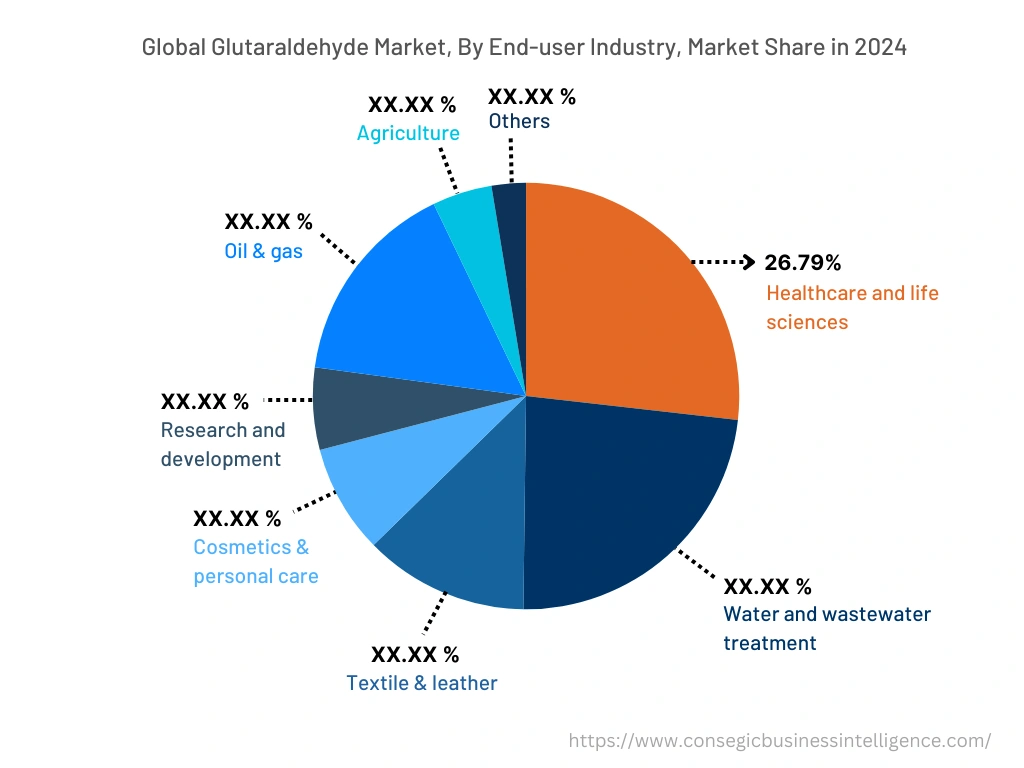
By Region :
The regional segment includes North America, Europe, Asia Pacific, the Middle East and Africa, and Latin America.
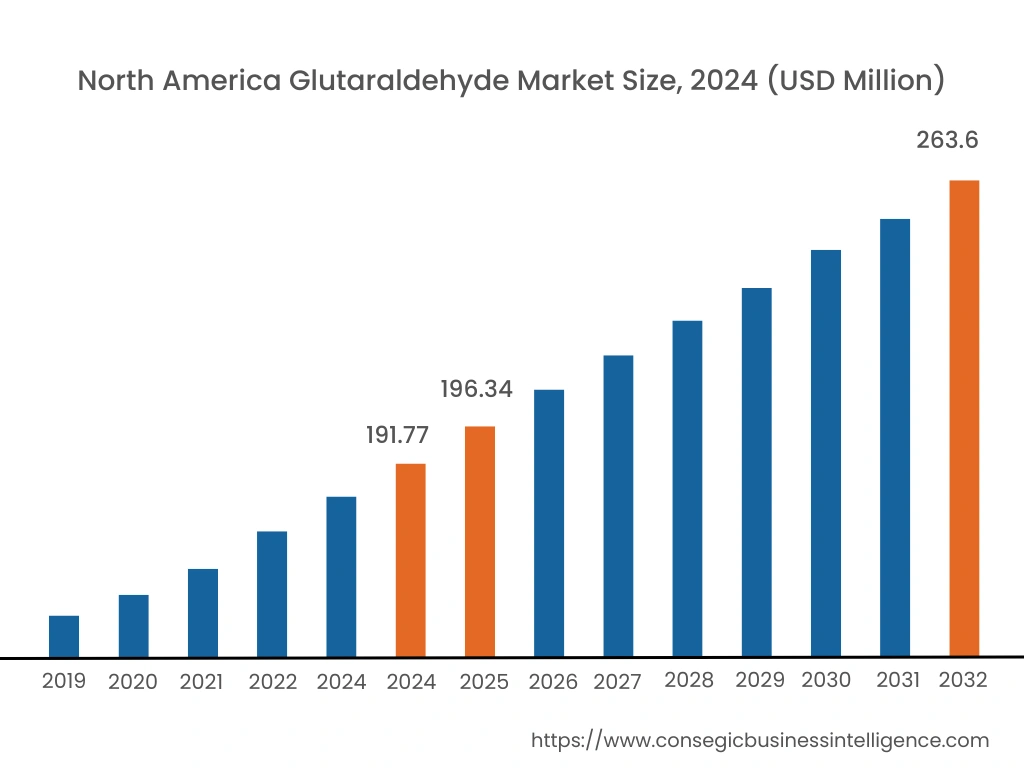
In 2024, North America accounted for the highest market share at 36.11% valued at USD 191.77 Million in 2024 and is projected to grow by USD 196.34 Million in 2025. It is expected to reach USD 263.6 Million in 2032. In North America, the U.S. accounted for the highest market share of 89.23% during the base year of 2024. Moreover, the analysis depicts that the increasing spending on pharmaceutical research and development activities in the region is driving the trend for pharmaceutical research activities. For instance, according to the report by the Congressional Budget Office in April 2021, 2019, the pharmaceutical sector spent USD 83 billion on research and development. Adjusted for inflation, that amount is about 10 times what the sector per year in the 1980s.
Furthermore, the Asia Pacific region is expected to witness a significant rise over the forecast period, growing at a CAGR of 5.1% during 2025-2032. The growing pharmaceutical, healthcare, and leather industries across the region are increasing the demand for disinfection and sterilization applications. Furthermore, the rising trend and significant development in industrial and municipal wastewater treatment activities across the region are expected to create lucrative opportunities for the glutaraldehyde market over the forecast period.
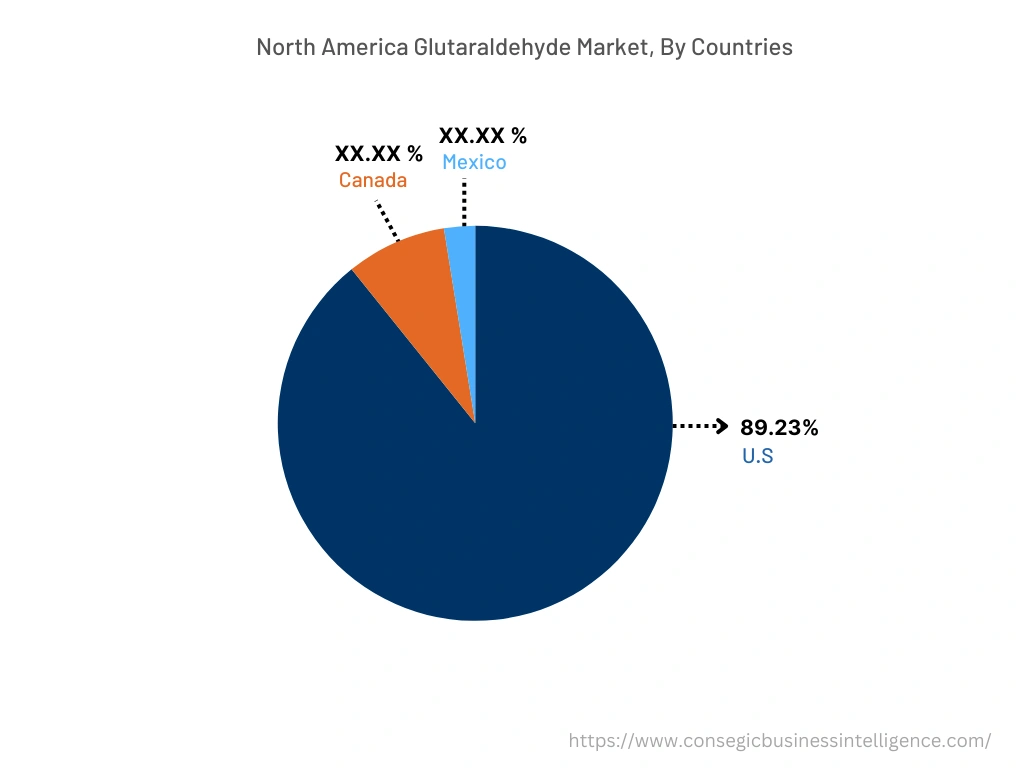
Top Key Players & Market Share Insights:
The glutaraldehyde market analysis depicts it as highly competitive, with several large players and numerous small and medium-sized enterprises. These companies have strong research and development capabilities and a strong presence in the market through their extensive product portfolios and distribution networks. The glutaraldehyde market is characterized by intense competition, with companies focusing on expanding their product offerings and increasing their market share through mergers, acquisitions, and partnerships. The key players in the glutaraldehyde industry include-
- Neogen Corporation
- AGRI International
- Finoric LLC
- Surfachem Group Ltd.
Recent Industry Developments :
- In July 2022, German specialty chemicals company Lanxess acquired the microbial division of International Flavors & Fragrances (IFF) for about USD 1.3 billion. The acquisition made Lanxess one of the world's largest suppliers of microbial control products.
Key Questions Answered in the Report
What was the market size of the glutaraldehyde industry in 2024? +
In 2024, the market size of glutaraldehyde was USD 578.13 Million.
What will be the potential market valuation for the glutaraldehyde industry by 2032? +
In 2032, the market size of glutaraldehyde will be expected to reach USD 813.34 Million.
What are the key factors driving the growth of the glutaraldehyde market? +
Significant growth in the healthcare industry in emerging economies across the globe is fueling market growth at the global level.
What is the dominating segment in the glutaraldehyde market for the end-user industry? +
In 2024, the healthcare & life sciences segment accounted for the highest market share of 26.79% in the overall glutaraldehyde market.
Based on current market trends and future predictions, which geographical region is the dominating region in the glutaraldehyde market? +
North America accounted for the highest market share in the overall glutaraldehyde market.
